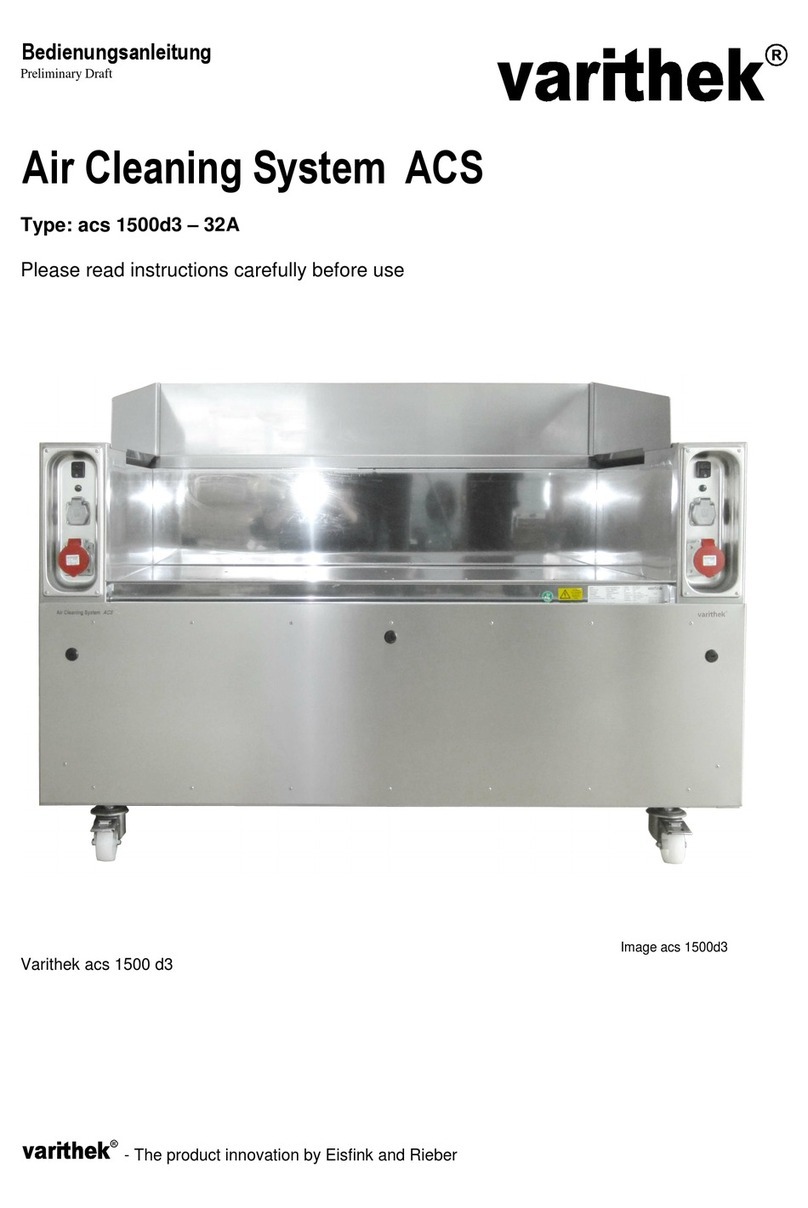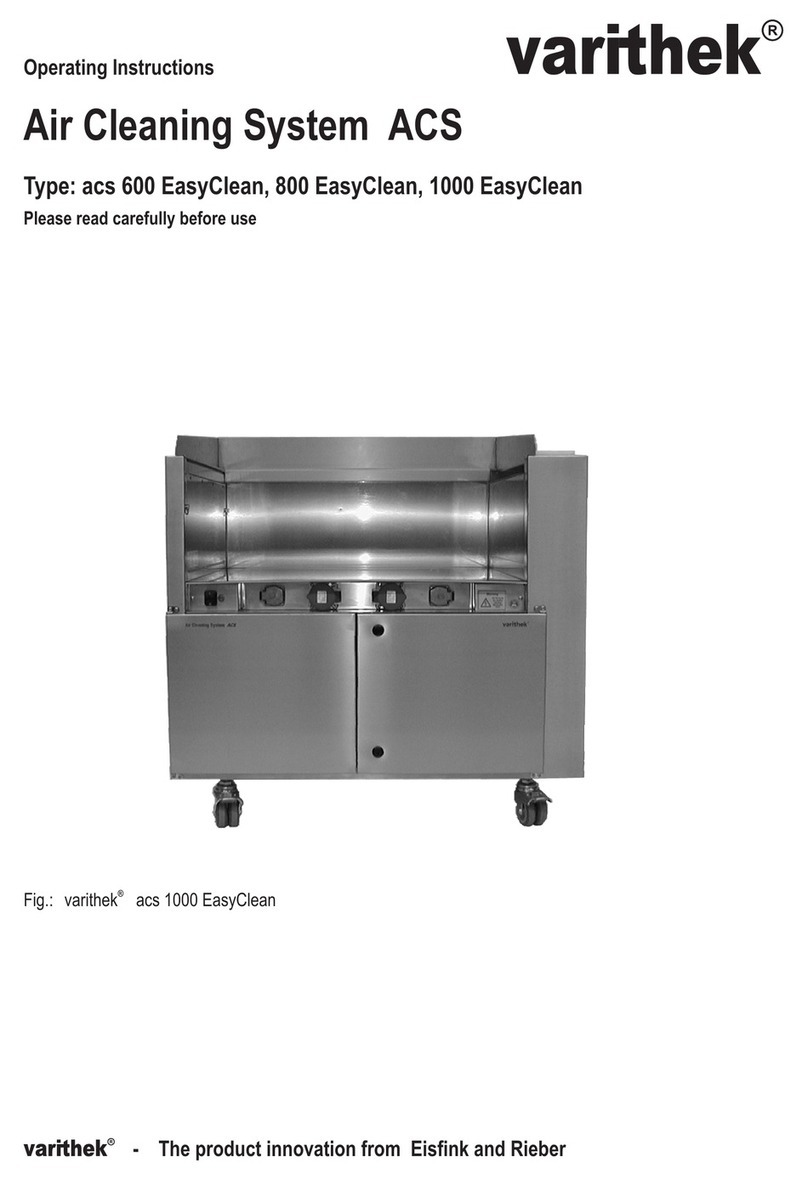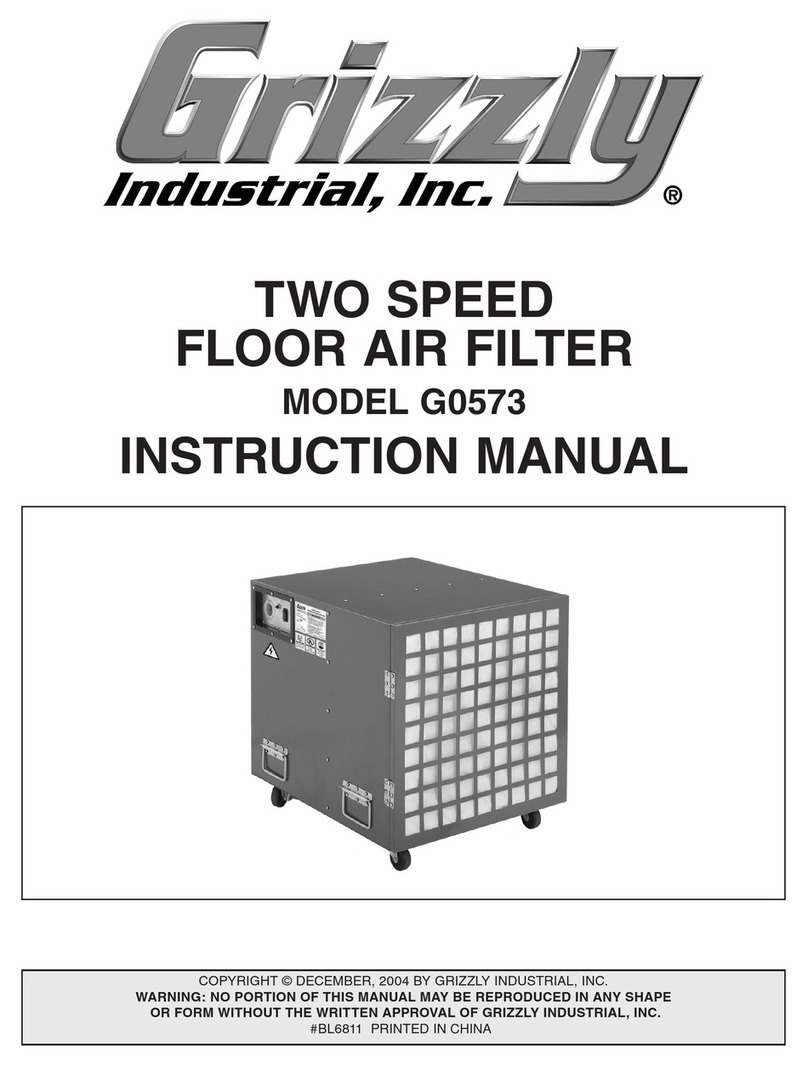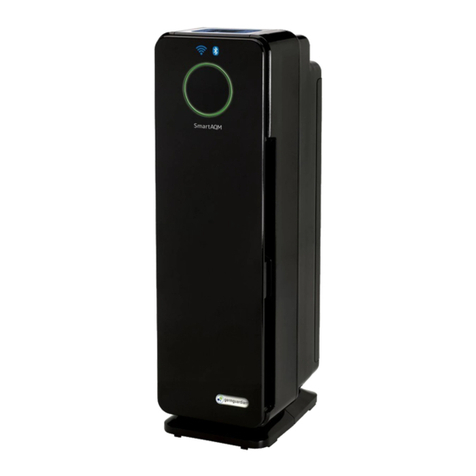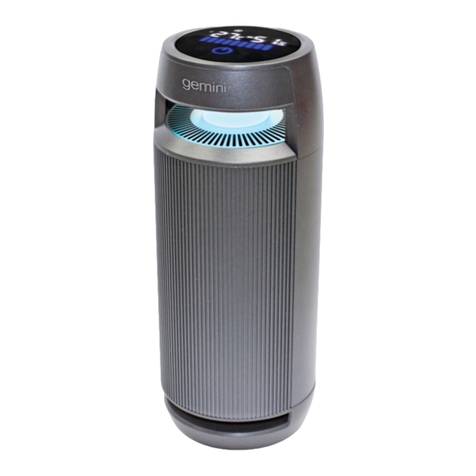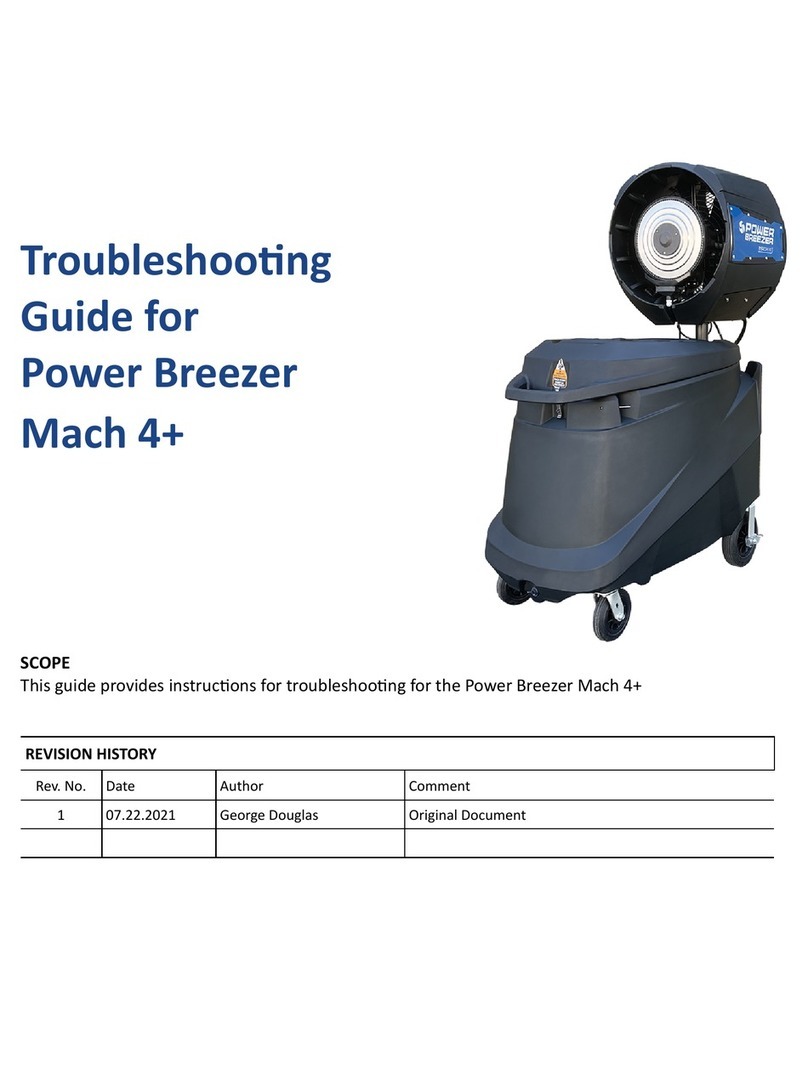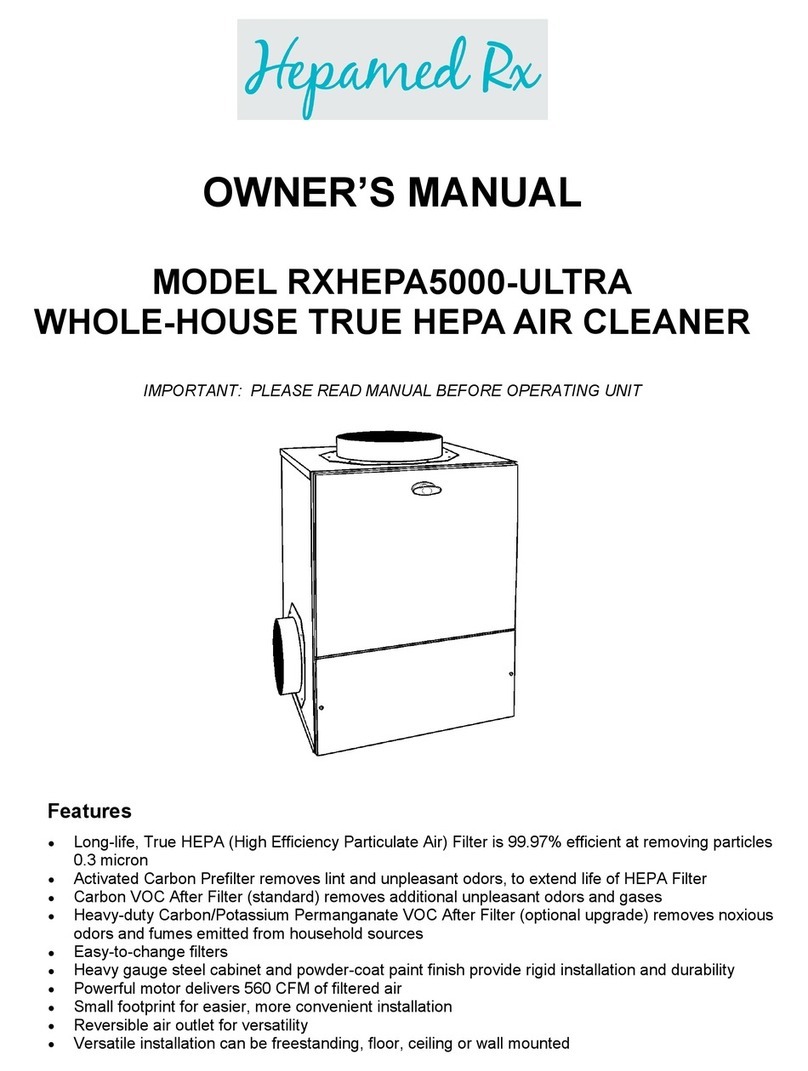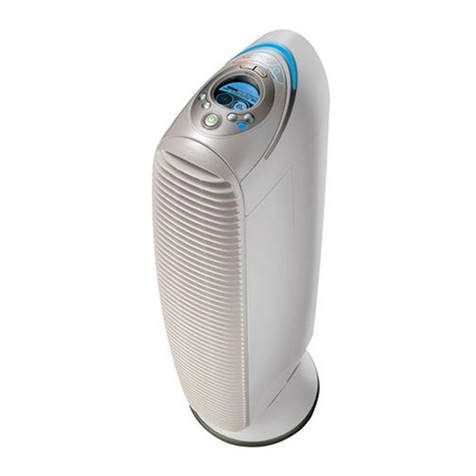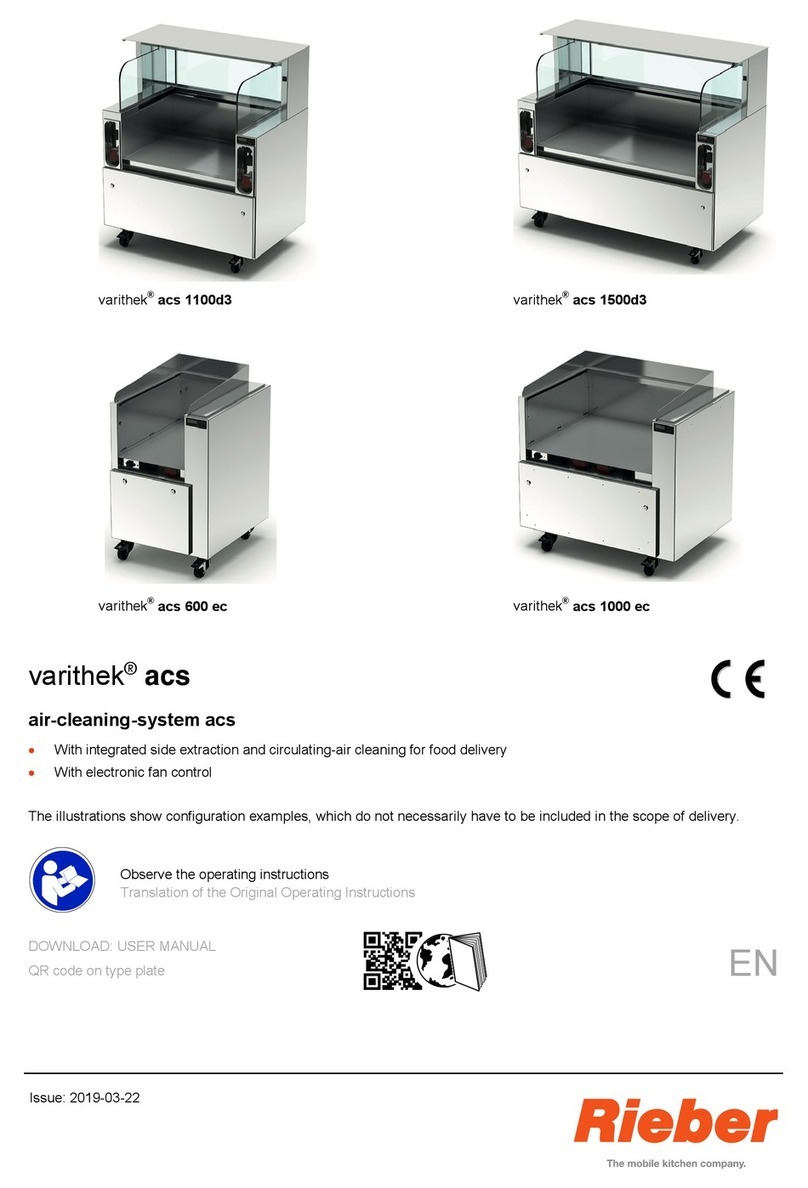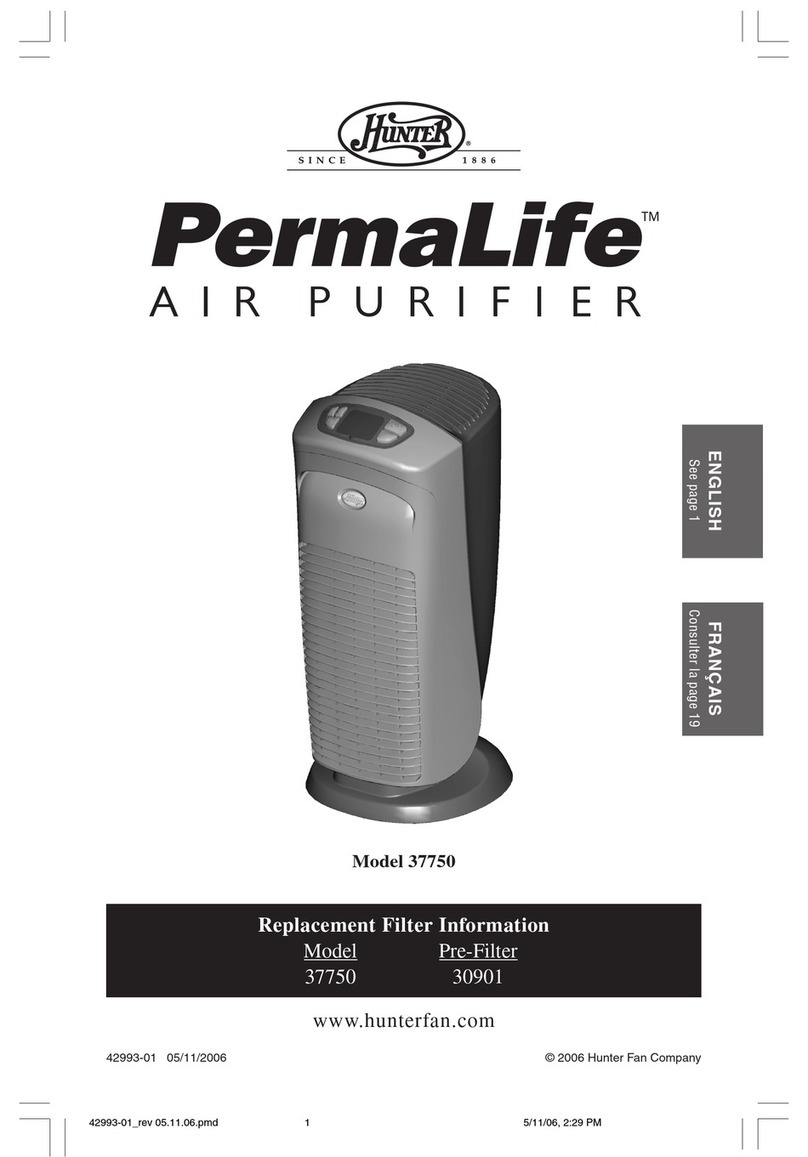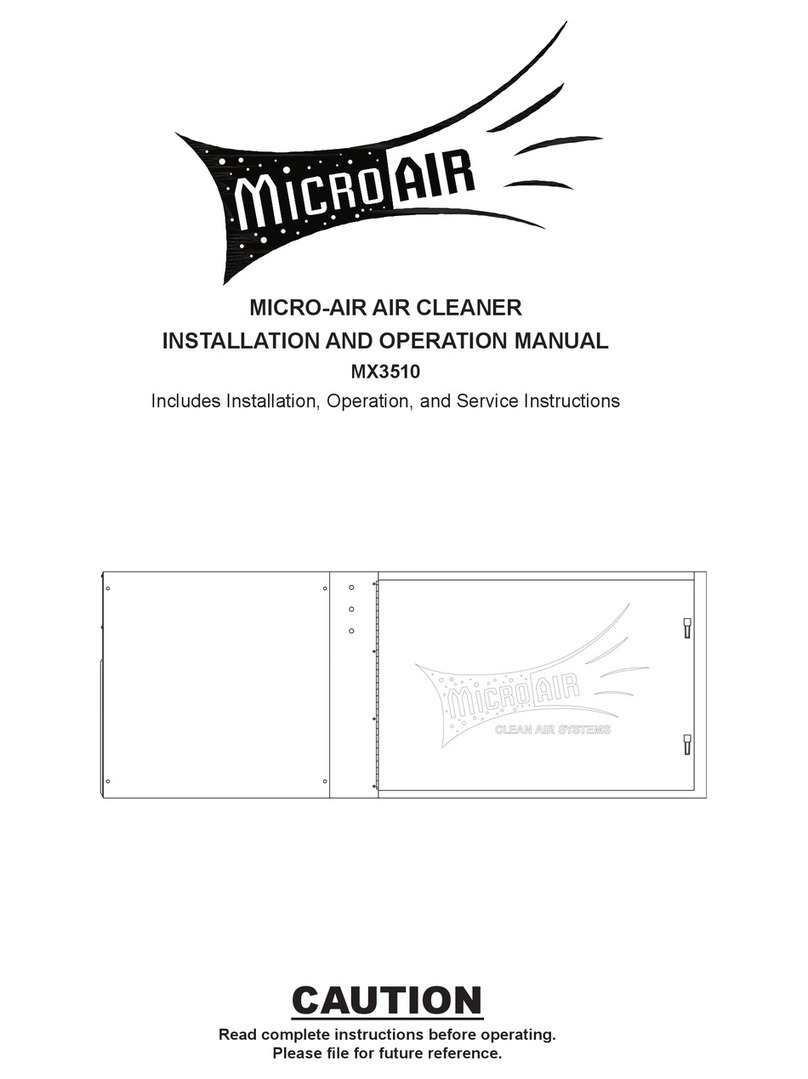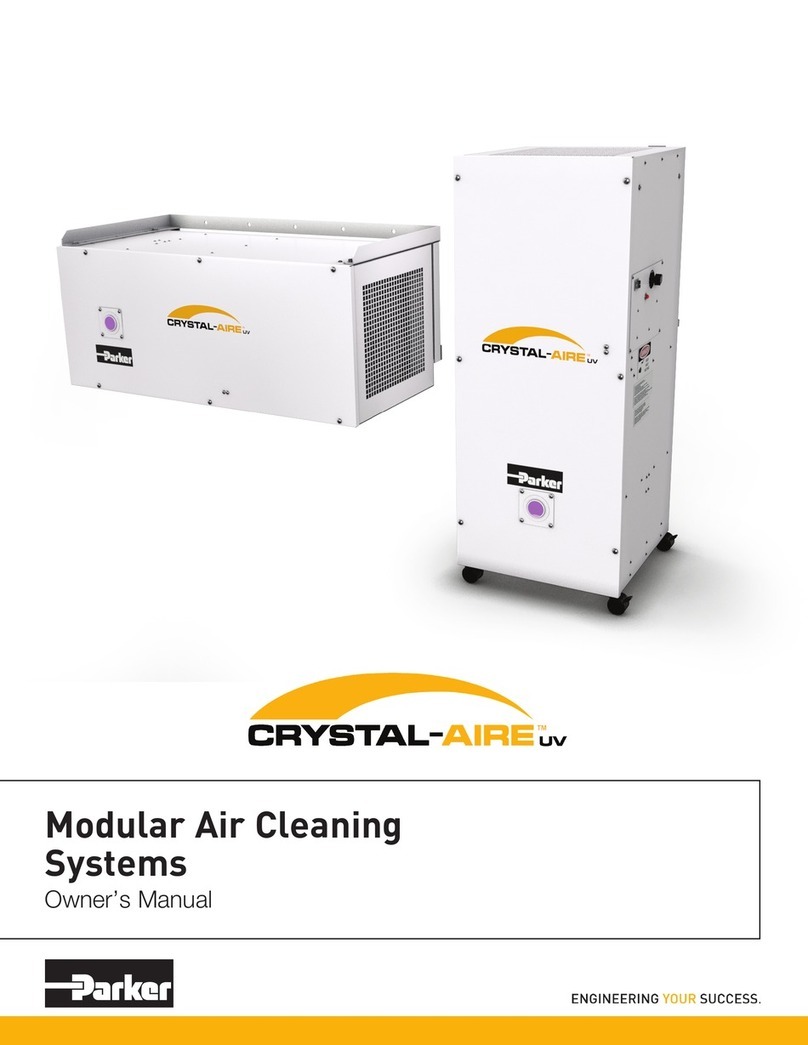eisfink varithek acs 1100 d3 User manual

Issue: 2018-06-07
varithek®acs®1100 d3
varithek®acs®1500 d3
varithek®acs®600 ec
varithek®acs®1000 ec
varithek
air-cleaning-system acs®
With integrated side extraction and circulating-air cleaning for food delivery
With electronic fan control
The illustrations show configuration examples, which do not necessarily have to be included in the scope of delivery.
Observe the operating instructions
Translation of the Original Operating Instructions
DOWNLOAD: USER MANUAL
QR code on type plate

Contents
2
Eisfink Max Maier GmbH & Co. KG
Our solutions guarantee high quality, safety and, above all,
excellent energy efficiency and cost effectiveness.
The basic task of the patented air-cleaning-system acs®is to collect the vapour and steam that occur
during cooking at the point of origin, clean them in a sophisticated filter system and then pass them back
into the room free from odours.
Contents
1Revision Index ................................................................................................................................................. 3
2Important Information ..................................................................................................................................... 4
2.1 Use of this guide ................................................................................................................................................4
2.2 Reference to trademark rights granted for these appliances ..............................................................................5
2.3 Representation conventions in the text ..............................................................................................................5
2.4 Structure of safety instructions...........................................................................................................................5
3General Safety Instructions............................................................................................................................ 6
3.1 General behaviour .............................................................................................................................................6
3.2 On use of electrical appliances ..........................................................................................................................6
3.3 Operator's obligations ........................................................................................................................................7
3.4 Qualification of personnel...................................................................................................................................8
3.5 Provision of protective equipment for personnel.................................................................................................8
3.6 Appliance-specific safety instructions.................................................................................................................9
3.7 Information about regulations to be followed....................................................................................................13
3.8 Instructions on behaviour in an emergency......................................................................................................14
4Purpose .......................................................................................................................................................... 14
5Description of the Equipment ...................................................................................................................... 16
5.1 Designation......................................................................................................................................................16
5.2 Technical data..................................................................................................................................................19
6Before First Use............................................................................................................................................. 21
6.1 Transport .........................................................................................................................................................21
6.2 Observe when commissioning/recommissioning..............................................................................................23
7Use.................................................................................................................................................................. 24
7.1 Only equip the appliances with suitable accessories........................................................................................25
7.2 Ensure undisturbed extraction of steam and vapours ......................................................................................27
7.3 Freshly prepare food on the cutting board........................................................................................................28
7.4 Switch appliance on and off electrically............................................................................................................28
7.5 Electronic fan control (option)...........................................................................................................................29
7.6 Clean the appliance after use ..........................................................................................................................32

Contents
Eisfink Max Maier GmbH & Co. KG
3
8Cleaning, Maintenance and Care ................................................................................................................. 33
8.1 Safety information relating to cleaning, maintenance and care ........................................................................33
8.2 Cleaning agents for stainless steel...................................................................................................................34
8.3 Overview of maintenance measures and intervals ...........................................................................................35
8.4 Choose the correct cleaning method................................................................................................................36
8.5 Clean and service stainless steel parts ............................................................................................................36
8.6 Clean casters ...................................................................................................................................................37
8.7 Clean and service plastic parts ........................................................................................................................37
8.8 Appliance type ‘ec’ ..........................................................................................................................................38
8.9 Clean cooking area and splash guard ..............................................................................................................40
8.10 Clean high-performance grease separator, grease drip trays … ......................................................................43
8.11 Inspect technical compartment; clean if necessary ..........................................................................................48
8.12 Disinfect the appliance as required ..................................................................................................................52
8.13 Keep ready for next use in dry condition ..........................................................................................................52
8.14 Ensure preservation of the product identification..............................................................................................52
9Troubleshooting............................................................................................................................................ 52
9.1 Notes on troubleshooting .................................................................................................................................52
9.2 Disposing of your product.................................................................................................................................54
10 Warranty and Liability................................................................................................................................... 55
11 Excerpt from EC Declarations of Conformity ............................................................................................. 55
12 Index............................................................................................................................................................... 56
13 Contact address ............................................................................................................................................ 56
1 Revision Index
Revision
Change
2013-10-01
New edition
2013-11-19
Potential equalisation system, damaged supply line
2014-04-11
Index
2015-06-15
General modification, adaptation to acs 1600 O3, ISO 82079,
VDE requirement, electronic fan control
2016-08-05
New Eisfink active carbon filter, plus electronic control
2018-06-07
Entfall 800 ec; Absaugung

Important Information
4
Eisfink Max Maier GmbH & Co. KG
2 Important Information
2.1 Use of this guide
This guide contains important information about how you can use the appliance safely and correctly.
►It is essential that you read the user guide before using the product for the first
time.
►Keep this guide in a safe place and pass it onto the next owner should you
wish to part with the product.
Our customers often express the wish to have one compact guide instead of a number of different
guides for these product variants, which have similar functions.
If there are any shortcomings in your opinion, please do not hesitate to let us know. With your help, we
will try to become even better.
Please add your notes here

Important Information
Eisfink Max Maier GmbH & Co. KG
5
2.2 Reference to trademark rights granted for these appliances
DE –Design patent no. 202 05 642.2 and no. 201 17 490.1
International patent application no. PCT/EP01/04469/ (WO 01/81831 A 1)
European Patent no. 1 194 721
2.3 Representation conventions in the text
Lists are represented in this way.
Instructions on certain actions are represented in this way.
See ‘. . . ’ cross-references are represented in this way
Notes
ATTENTION
indicates potential damage to property without any personal injury.
Failure to follow these instructions may cause damage to property.
User tip
►Useful information or tip
2.4 Structure of safety instructions
The signal words DANGER - WARNING - CAUTION classify the degree of risk of bodily injury in an actual
situation. You can avoid injury by complying with the behavioural rules provided.
The warning triangle symbol indicates a "General Danger".
DANGER
indicates imminent danger.
Failure to follow these warning instructions will result in serious bodily injury or even
death.
WARNING
indicates a potentially hazardous situation.
Failure to follow these warning instructions may cause serious bodily injury or even
death.
CAUTION
indicates a potentially harmful situation.
Failure to follow these warnings may cause minor bodily injury.

General Safety Instructions
6
Eisfink Max Maier GmbH & Co. KG
3 General Safety Instructions
This section covers residual risks and hazards associated with the intended use of the appliance. We have
provided a list of all generally valid safety instructions which must be followed.
In the following section, safety information relating to a particular operation or situation is placed before the
appropriate operation step or description of the situation.
The information provided here such as ‘Basic rules of conduct’, ‘Operator's obligations’ etc. only refers to the
legally required observance of requirements such as the Workplaces Ordinance (ArbStättV) according to
German law.
3.1 General behaviour
This appliance meets the current state of the art and complies with all acknowledged technical safety-
related regulations. Nevertheless hazards may still arise.
Only use this appliance when it is in fault-free condition and according to the instructions in this
user guide.
During all phases of the appliance's life please ensure that the appliance is safely integrated into
its environment.
Do not make any conversions or modifications to the appliance.
3.2 On use of electrical appliances
Safety instructions according to EN 60745-1:
Work area
Keep your work area clean and tidy. A messy or unlit work area can cause accidents.
Keep children and other persons at a distance when using the product.
Electrical safety
The plug on the unit must fit in the socket. Do not modify the plug in any way. Never use
an adapter in combination with earthed appliances. Using an unmodified plug and a
suitable socket will reduce the risk of an electric shock.
Keep the appliance away from rain or damp. Allowing water to get into an electric
appliance will increase the risk of electric shock.
Do not misuse the cable by using it to remove the plug from the socket. Always remove
whilst holding onto the plug. Keep the cable away from heat, oil, sharp edges or the
moving parts of other appliances. Using damaged or tangled cables increases the risk of
electric shock.
Potential risk of fire due to heat build-up. Unwind the cable from the spool to prevent any
heat build-up or cable fire. The coupling must have splash protection, must be made of
rubber or be rubber-coated.
Safety guidelines for persons
Be attentive and pay attention to what you are doing, act rationally when working with an
electrical appliance. Do not use the appliance when tired or under the influence of drugs,
alcohol or medication.
Just one moment of inattention whilst using the appliance can result in serious injury.
Make sure the appliance cannot be switched on unintentionally. Double check that the
main switch is in the "OFF" position before inserting the plug in the socket. Connecting
the appliance to the power supply while it is switched on can cause an accident.

General Safety Instructions
Eisfink Max Maier GmbH & Co. KG
7
Careful handling and use of electrical appliances
Never use an electrical appliance with a faulty switch. An electrical appliance which can
no longer be switched on or off is dangerous and must be repaired.
Keep unused electrical appliances in places where children are not able to reach them.
Do not allow the appliance to be used by persons who are not familiar with it or persons
who are not familiar with this user guide. Electrical appliances are dangerous when in the
hands of inexperienced persons.
Treat the device with care. Check that moving parts are functioning properly and do not
block; check whether parts are broken or damaged and impairing the functioning of the
device. Have any damaged parts repaired before using the appliance. Many accidents
are caused by poorly-maintained electrical appliances.
Use electrical appliances, accessories etc. in accordance with these guidelines and in a
manner that is specified for this particular appliance type. When using the appliance,
please take into account the working conditions and the work being carried out. Using
electrical appliances for other uses than that intended can lead to hazardous situations.
Service
Only have the device repaired by qualified and authorised staff. Only use original spare
parts. In this way you can ensure that the appliance remains safe.
3.3 Operator's obligations
Operator
The operator is the person who operates the appliance for commercial or economic purposes either
himself/herself or lets others use it and bears the legal appliance responsibility for protection of the
user, staff or any third parties during operation.
Operator's obligations
The appliance is used in commercial applications. For this reason, the operator of the appliance must
meet all legal duties relating to work safety.
In addition to the safety instructions in this guide, the safety, accident prevention and environmental
protection regulation applying to the application of the appliance must be complied with.
In particular, the following shall apply:
The operator must be familiar with the applicable work safety regulations and identify, by
carrying out a risk analysis, any additional hazards which are due to the place where the
appliance is used. These hazards must be addressed in the form of operating instructions
governing the operation of the appliance.
During the whole service life of the appliance, the operator must verify if the operator's
operating instructions reflect the current versions of the applicable regulations. If necessary,
the operator must update the operating instructions accordingly.
The operator must define and assign the responsibilities for installation, operation, repair,
maintenance and cleaning clearly.
The operator must make sure that all personnel working with the appliance have read and
understood this guide. In addition, the operator must train the personnel and inform them of
the hazards involved at regular intervals.
The operator must provide the personnel with the necessary protective equipment and
make sure that they wear it.

General Safety Instructions
8
Eisfink Max Maier GmbH & Co. KG
In addition, the operator must ensure that the appliance is always in a perfect technical condition. For
this reason, the following shall apply:
The operator must ensure that the maintenance intervals defined in this guide are obeyed.
The operator must have all safety equipment checked regularly for completeness and
proper function.
The operator must ensure that the required media connections are available.
The operator must ensure that all safety-relevant measures required on site are taken.
3.4 Qualification of personnel
Safe operation requires certain technical skills and personal qualification of each person.
The responsibility for organization lies with the ‘Designated Representative’ (operator).
According to EN 50110-1, the Designated Representative is a 'person assigned the direct
responsibility for the performance of the work. If necessary, this responsibility can be
assigned partly to other persons. [...] The designated representative must instruct all
persons involved in the work on all hazards which may not be obvious for them’.
The work may only be performed by ‘instructed persons’ who have been trained
accordingly. Training, instructions must be repeated, proper understanding must be verified
(ideally by way of an appropriate test).
Only ‘Qualified Staff’ are allowed to carry out repair work.
IEC 60204-1 defines qualified personnel as "persons who, on account of their training and
relevant experience are in the position to recognise risks and avoid potentially dangerous
situations."
Electrical work may only be carried out by trained and experienced electricians.
Electro-technically instructed persons may only work under the supervision of a qualified
electrician.
Any repairs and/or overhaul during the warranty period may only be carried out by the
manufacturer´s service department.
Chapter ‘Warranty and Liability’, page 55
3.5 Provision of protective equipment for personnel
Ensure that the personnel wear the personal protective equipment appropriate to the relevant
situation.
Wear safety shoes to prevent injuries when transporting or moving the appliance.
Wear protective gloves to prevent burns to hands and arms when using the cooking accessories.

General Safety Instructions
Eisfink Max Maier GmbH & Co. KG
9
3.6 Appliance-specific safety instructions
This chapter describes general, appliance-specific safety instructions. In the following section, additional safety
information relating to a particular operation or situation is placed before the appropriate operation step or
description of the situation.
3.6.1 Risks due to cooking accessories
All kinds of risks may occur if the wrong cooking accessories are selected.
User tip
The cooking modules in the Rieber varithek®range are recommended. Baking, grilling, cooking,
wok cooking and frying.
Observe the instructions in the relevant operating manuals.
# Deep-fryer
For the deep-fryer, use an insertion mask that prevents slipping into the system carrier.
3.6.2 Risks due to ventilation, circulating-air cleaning
The unit's extraction and circulating-air cleaning is not a replacement for an air-conditioning system.
Always ensure an adequate supply of fresh air.
Risks due to human error when using the Eisfink active carbon filter for odour and
contaminant absorption and odour elimination using plasma technology
WARNING
Breathing difficulties, lacrimal irritation, mucosal irritations in throat, neck and lungs,
headache, strong tickle in the throat, cannot be excluded in the case of human error.
►Only use with Eisfink active carbon filters, which are correctly mounted.
►Do not interfere with the extraction and circulating-air cleaning: Do not place any
objects on the Eisfink active carbon filter in the technical compartment. Only operate
with a dry Eisfink active carbon filter.
Fire risks
Risk of fire
Risk of fire due to missing or incorrectly mounted filter components.
►Only use with original filter components and grease drip trays, which are correctly
fitted.
►Clean filter area daily.
Chapter ‘Cleaning, Maintenance and Care’, page 33 ff.

General Safety Instructions
10
Eisfink Max Maier GmbH & Co. KG
3.6.3 Risks due to opened technical compartment
The technical compartment contains a rotating fan wheel. Keep the technical compartment closed. Use
a suitable tool to open and close the technical compartment.
Before opening the technical compartment
Switch off the ‘ON/OFF pushbutton with indicator light’ and
Switch off the electrical power to the unit by unplugging the main plug.
3.6.4 Risks due to transport of mobile appliance
Numerous hazards such as crushing can arise when transporting this heavy product 110 to 160 kg.
Remove accessories and transport them separately.
Disconnect the connection cable.
Only transport unit on a straight surface. Do no transport on a sloping surface.
Carry out transport with an adequate number of people, at least two.
Transport only permissible using the casters.
Secure the appliance against inadvertently rolling away with the ‘parking brake’.
Wear safety shoes to prevent injuries.
ATTENTION
Observe the permissible step height of maximum 4 mm, otherwise the ‘casters with parking brake’
could be damaged.
Do not push or pull the appliance over sharp edges; Otherwise the casters could sustain damage.
Do not use this appliance with poor floor conditions.
We are not able to rule out the possibility of marks appearing on the floor due to friction with
casters or the formation of scratches due to split cracks in the casters, for example.
We are not able to rule out the possibility that the casters may be damaged or become unusable
due to swelling or sharp edges on the floor.
Mobile appliances may only be moved manually. Machine-aided transport, e.g. using fork lift trucks
or lift trucks, is not permissible. Risk of injury and risk of damaging the appliance.

General Safety Instructions
Eisfink Max Maier GmbH & Co. KG
11
3.6.5 Dangers due to electricity
Before each use, inspect the product, the connecting plug and electric cable for any visible signs
of damage.
The cable must be routed so that it cannot be squeezed or overheated.
The socket outlet must be easily accessible so that the unit can be disconnected from the power
supply at any time.
Compare the connection data on the type plate with the data of the electrical network before
connecting (voltage and frequency, power rating).
3.6.6 Risks due to power interruption possible
Possibility of malfunction after power interruption.
Disconnect the unit from the mains completely after a power failure.
Then switch back on.
3.6.7 Warnings concerning the use of the appliance by children
This appliance may be used by children over 12 and by persons with limited physical,
sensory and intellectual abilities or a lack of experience and/or knowledge if they are
supervised or if they were instructed in the safe use of the appliance and have understood
the resulting dangers.
When using the appliance with ‘accessories’, other risks may arise.
Children may not play with the appliance.
Cleaning and user maintenance may not be carried out by children without supervision.
3.6.8 Safety and monitoring devices
High-performance grease separator (100% flame propagation proof) with Cyclone®blade
profile (separation efficiency approx. 95%)
In addition to protection against electric shock and in order to ensure that the frames of
electrical equipment and any external conductive components are at an equal (or practically
equal) potential, the appliance must be connected to the potential equalisation system.
The connection of all conductive bodies (housing) of electrical equipment to an earthed
protective conductor and the main earthing bar is the basic principle for protection against
electric shock.
For variant with odour elimination using plasma technology:
Pressure sensor monitors the pressure conditions in the technical compartment; in the
event of a fault the plasma generator is switched off

General Safety Instructions
12
Eisfink Max Maier GmbH & Co. KG
3.6.9 Product identification
Product identification at the housing, outside
The type plate bears the legally required product data.
The technical compartment is identified.
High-performance grease separators are marked with raised points. These markings can
also be found on the counterpart or frame.
‘Clean filter area daily’.
Equipotential bonding on the underside of the appliance. Note the symbol.
Product identification, especially 600 ec, 1000 ec, 1100 d3
(Variant with 16 A)
Only connect varithek®appliances with the same voltage, i.e. 400 V or 230 V.
Product identification in technical compartment for all appliance types
‘WARNING
Unplug mains plug before removing the fan device.’

General Safety Instructions
Eisfink Max Maier GmbH & Co. KG
13
Product identification in technical compartment for variant with Eisfink active carbon
filter for odour and contaminant absorption and odour elimination using plasma technology
WARNING
Health risks, respiratory disorders
►Only use Eisfink active carbon filter, install correctly.
►Do not place any objects on the
Eisfink active carbon filter.
►All interference with the plasma generator is forbidden.
Product identification in technical compartment for appliance type ‘ec’‘Setting mark’
In the technical compartment, the bottom opening on the left in the floor of the technical compartment
set by the manufacturer is to be left as is.
3.7 Information about regulations to be followed
In addition to this user guide there are a range of health and safety and other regulationsthat are
relevant for the operation of this cooking station; these include HACCP food hygiene regulations for
example.
# Fulfillment of standards and guidelines
VDI directive 2052 Air-conditioning systems. The unit's extraction system is not a
replacement for an air-conditioning system.

Purpose
14
Eisfink Max Maier GmbH & Co. KG
3.8 Instructions on behaviour in an emergency
In an emergency always interrupt the power connection immediately, by disconnecting the
electrical connector.
First aid in the case of burns and scalding or electric shock:
Inform yourself on this before commissioning the appliance.
Store the emergency equipment, including the relevant instructions, at a readily accessible place
near the place of use.
User tip
►Inform yourself in details by reading the in-house operating instructions.
►We recommend that half-yearly emergency training sessions should be carried out.
First aid in the case of unaccountable irritations of the mucous membranes, strong urge to
cough when using appliances with additional odour elimination using plasma technology
WARNING
Breathing difficulties, lacrimal irritation, mucosal irritations in throat, neck and lungs,
headache, strong tickle in the throat, cannot be excluded in the case of human error.
►Only use with Eisfink active carbon filters, which are correctly mounted. Replace active
carbon filters after at least 500 operating hours.
►Do not interfere with the extraction and circulating-air cleaning. Do not place any
objects on the active carbon filter in the technical compartment, for example. Only
operate with a dry Eisfink active carbon filter.
►Seek medical treatment if necessary. Ozone-containing air can trigger complaints.
4 Purpose
This chapter describes the intended use and contains warnings against misuse, for your safety.
Generally, the following are intended uses for the product:
For mobile service in the catering, hotel, and food processing industry; also suitable for the
care and school catering sectors.
Use correctly sized cooking units, like the cooking modules in the Rieber varithek® range.
Baking, grilling, cooking, wok cooking and frying. The relevant operating instructions must
be observed.
The patented air-cleaning-system®(acs®) collects the vapour and steam that occur during
cooking at the point of origin, cleans them in a sophisticated filter system and then passes
them back into the room free from odours.
To prevent persons from burning themselves on hot surfaces, use of the product in
public/for self-service should only be allowed under constant supervision.

Purpose
Eisfink Max Maier GmbH & Co. KG
15
The variant with Eisfink active carbon filter for odour and contaminant absorption and odour
elimination using plasma technology is intended for applications requiring a high level of
odour neutralisation.
The intended use includes compliance with the technical data. Note the information on the
rating plate as well as the product identification.
Equipotential bonding must be carried out by a qualified electrician.
For use only by appropriately trained and suitable operating personnel.
Prevent any potential misuse in advance:
Only use with original filter components, which are correctly mounted.
Only Use correctly sized cooking units, such as the cooking modules in the Rieber varithek®
range.
Provide the unit with electrical fuse connection on site.
The integrated air-cleaning-system acs®ensures that the extracted air is passed back into
the room odour-free. This is not a replacement for an air-conditioning system.
For variants with Eisfink active carbon filter and odour elimination using plasma technology:
Any inference in the ‘plasma generator’ is forbidden.
In appliance type ‘ec’: in the technical compartment, do not adjust the bottom opening
which has been correctly set by the manufacturer. Can be recognised by product
identification with ‘Setting mark’.
Only use one deep-fryer per the appliance, as otherwise the extraction and circulating air
cleaning system may be overloaded and odours may develop.
Do not use gas cooking units, as this can be dangerous.
Do not flambé, as this can be dangerous.
Never operate the appliance unsupervised. To prevent persons from burning themselves on
hot surfaces, use of the product in public, e.g. for self-service, should only be allowed under
supervision.
Front cooking is only admissible with the sneeze guard that can be closed on four sides.
Observe the Food Hygiene Regulations under German law.
Not intended for private use at home.
Do not lean against or sit on the appliance.
Incorrect cleaning can substantially and irreparably damage the stainless steel surfaces.
Do not push or pull the appliance over sharp edges; Otherwise the casters could sustain
damage.
Do not use this appliance with poor floor conditions.
We are not able to rule out the possibility of marks appearing on the floor due to friction with
casters or the formation of scratches due to split cracks in the casters, for example.
We are not able to rule out the possibility that the casters may be damaged or become
unusable due to swelling or sharp edges on the floor.
Mobile appliances may only be moved manually. Machine-aided transport, e.g. using fork
lift trucks or lift trucks, is not permissible. There is a risk of injury and substantial damage to
the appliance.

Description of the Equipment
16
Eisfink Max Maier GmbH & Co. KG
5 Description of the Equipment
This chapter provides useful information on the structure and function of the equipment.
5.1 Designation
The illustration shows a configuration example which does not necessarily have to be included in the scope of
delivery.
5.1.1 Appliance type ‘d3’
Appliance type ‘d3’ means three- sided extraction Extraction of steam and vapour.
Extraction at front left / right or on both sides and at the back.
Example
1500 d3
1 4 swivel casters, including 2 ‘swivel casters with parking brakes’ on the operator side
→ Always secure the position of the appliance with the parking brakes.
2 Technical compartment
3 Power connections for cooking units
4 Extraction areas →three-sided extraction of steam and vapour
5 Splash guard; removable for cleaning → option
6 Sneeze guard attachment, including shelf for serving food → option
7 Operating elements, power connections for cooking units
The electrical connection with cable and plug is located at the back of the product.

Description of the Equipment
Eisfink Max Maier GmbH & Co. KG
17
Appliance type ‘ec’
Appliance type ‘ec’ means ‘EasyClean’, German ‘Einfach reinigen, one- sided extraction of steam
and vapour. The extraction system (push & pull system) is designed in such a way that the vapour
created when cooking and roasting is collected by a transversally running air stream and is extracted
into the side flank.
Example
600 ec
1 4 swivel casters, including 2 ‘swivel casters with parking brakes’ on the operator side
→Always secure the position of the appliance with the parking brakes.
2 Technical compartment
3 Operating elements, power connections for cooking units
4 sided extraction of vapour and steam
4.1 Air supply area →from radial fan
4.2 Extraction area →one-sided extraction of steam and vapour
5 Splash guard; removable for cleaning
6 Cutting board →fresh preparation of food on the cutting board.
The electrical connection with cable and plug is located at the back of the product.
5.1.2 Cooking units
User tip
Only use correctly sized cooking units.
►Use cooking modules from the Rieber varithek®range. Baking, grilling, cooking, wok
cooking and frying.

Description of the Equipment
18
Eisfink Max Maier GmbH & Co. KG
5.1.3 Extraction and circulating-air cleaning
Appliance type ‘d3’: The acs®side extraction systems in appliance type ‘d3’ are designed in such a
way that the generated steam is extracted on three sides; Extraction at front left / right or on both sides
and at the back.
The variant "Eisfink active carbon filter for odour and contaminant absorption and odour elimination
using plasma technology" is intended for applications requiring a high level of odour neutralisation.
Appliance type ‘ec’: In appliance type ´ ec´, the extraction system (push & pull system) is designed in
such a way that the vapour created when cooking and roasting is collected by a transversally running
air stream and extracted into the side flank.
Schematic
diagrams
↑ Appliance type ‘d3’
↑ Appliance type ‘ec’
1 High-performance grease separator
2 Grease drip trays, removable
3 Radial fan
4 # Model type A:Eisfink active carbon filter
# Model type B: Eisfink active carbon filter for odour and contaminant absorption and odour
elimination using plasma technology
The plasma generator converts odorous substances into odourless substances.
Germs and odour-causing bacteria are also killed in the process.
Active carbon filter. Adsorbed substances accumulate in the carbon. Substances to
be filtered are physically absorbed by means of the active carbon filter. When the
capacity is exhausted, the filter must be replaced.
A wet active carbon filter is unusable. Never dry a wet Eisfink active carbon filter in the
oven or dryer, as there is a risk of fire. Let the active carbon filter dry in dry ambient air.

Description of the Equipment
Eisfink Max Maier GmbH & Co. KG
19
5.1.4 Sneeze guard attachment /Option
Standard:
3-sided splash guard made of stainless steel.
Option:
Sneeze guard attachment, including storage space for food delivery made of composite
safety glass and lighting.
Option
5.2 Technical data
5.2.1 Generally applicable data
Rated voltage / mains
frequency
3N AC 400V 50/60Hz,
Equipotential bonding on the underside of the appliance. This protective
measure serves for additional safety. Standard-compliant
implementation with subsequent inspection of the system is carried out
by a qualified electrician.
IEC 60364-5-54:2011;
for Germany DIN VDE 0100:540:2012-06
Protection class
IPX4 according to DIN EN 60529
→Unit offers protection against water splashes on all sides.
→Only use unit inside buildings. Protection against penetrating
moisture is required.
Ambient temperature
+5 °C to +40 °C
3-sided splash guard
Detachable splash guard made of chromium-nickel steel
CNS 1810 (WN 1.4301). Laminated safety glass optional
Rustproof casters
In accordance with DIN 18867, Part 8. 4 height-adjustable swivel
casters made from chromium-nickel steel CNS 1810 (WN 1.4301),
wheel diameter 80 mm.
Including 2 ‘swivel casters with parking brakes’ on the operator side;
Option: 4 stands, height-adjustable
Material
Stainless steel CNS 18/10, WN 1.4301
Circulating air cleaning
Radial fan,
High-performance grease separator (100% flame propagation proof)
with Cyclone ®blade profile (separation efficiency approx. 95%),
Grease drip trays. In addition
Version A: Eisfink active carbon filter
Model type B: Eisfink active carbon filter for odour and contaminant
absorption and odour elimination using plasma technology

Description of the Equipment
20
Eisfink Max Maier GmbH & Co. KG
5.2.2 Concerning appliance type ‘d3’
varithek®acs®1100 d3
varithek®acs®1500 d3
Power consumption
Maximum 11 kW / 22 kW
maximum 22 kW
Electrical fuse
Connect the unit on site to a socket with a series-connected residual
current operated device (RCD) with a tripping current of 30 mA.
16 A: Only connect appliances that have the same voltage, i.e.
400 V or 230 V.
32 A: Automatic circuit breaker for integrated power outlets in the
device, right installation compartment.
Permissible loading
maximum 80 kg
maximum 120 kg
Air capacity in accordance with
DIN 61591
Circulating air 1150 m3per hour
Circulating air 1250 m3per hour
External dimensions
(L x W x H) approx.
1100 x 722 x 900 (1100) mm
1500 x 770 x 900 (1100) mm
Placement niche (L x W x H)
approx.
805 x 615 x 260 mm
1205 x 660 x 260 mm
Weight approx.
115 kg
155 kg
Emitted sound pressure level
Lpa ≤70 dB(A)
Lpa ≤70 dB(A)
Electrical connection
Approx. 3 m cable / CEE plug 3x 16 / 32 A / L1 / L2 / L3 / N / PE
5.2.3 Relating to appliance type ‘ec’
varithek® acs® 600 ec
varithek®acs®1000 ec
Power consumption
Maximum 11 kW
Maximum 11 kW
Electrical fuse
16 A. Connect the unit on site to a socket with a series-connected
residual current operated device (RCD) with a tripping current of 30 mA.
Only connect appliances that have the same voltage, i.e. 400 V or 230 V.
Permissible loading
maximum 40 kg
maximum 80 kg
Air capacity in accordance
with DIN 61591
Circulating air 750 m3per hour
External dimensions
(L x W x H) approx.
600 x 720 x
900 (1000 1) mm
1000 x 720 x
900 (1000 1) mm
Placement niche
(L x W x H) approx.
405 x 690 x 260 mm
805 x 690 x 260 mm
Weight approx.
110 kg
140 kg
Emitted sound pressure
level
Lpa ≤70 dB(A)
Connected load
3N AC 230 V / 400 V, 50 Hz, 16 A, maximum 11 kW
Electrical connection
Approx. 3 m cable / CEE plug 3x 16 A / L1 / L2 / L3 / N / PE
For detailed information on dimensions, order number, accessories, circuit diagrams, spare and
wearing parts:
see type plate, catalogue, brochure
1
Complete with splash guard
This manual suits for next models
3
Table of contents
Other eisfink Air Cleaner manuals
